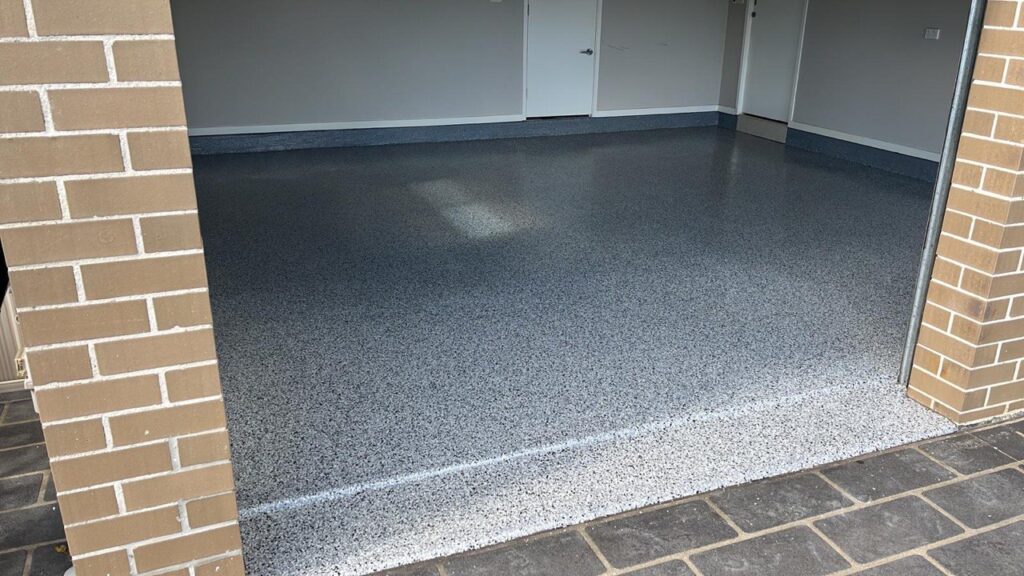Using epoxy flooring on concrete surfaces can be a good idea for many reasons. These include durability, ease of application, and low cost. But what should you know before you start?

Preparing the substrate
Whether you are installing epoxy flooring on a new concrete slab or over a surface that has already been coated with a resin based floor, the substrate must be prepared properly. If done correctly, the substrate can be cleaned, primed, and prepared for the epoxy coat. Once the primer has cured, the epoxy layer can then be applied.
The proper preparation of the concrete substrate is important for several reasons. First of all, the surface must be clean and free from all debris. Second, the epoxy coating system must adhere well to the surface. Finally, it is essential to determine the pH of the concrete substrate. The substrate’s pH level is important because it affects the overall adhesion of the polymer system.
The best way to prepare the concrete substrate for an epoxy layer is by removing all loose tile and cracks. This can be done with a Diamabrush.
DUROFLOOR (A+B) mixed with quartz sand
Adding quartz sand to epoxy flooring is an ideal way to add extra slip resistance to the surface. It also provides a textured surface, making the floor easier to clean. In addition, quartz helps the layers bond together.
The process of adding quartz sand to epoxy flooring is very simple. It usually involves broadcasting the material over a wet primer. Then, it is allowed to dry for a couple of hours. This will allow the sand to strengthen the epoxy mixture, and improve the smoothness of the coats.
The epoxy material should be stored in a room with a temperature of 70 degrees or lower. This will reduce working time. Xylene should be used to thin the epoxy if it is too thick. Using a squeegee will spread the primer evenly.
Filling and repairing
Whether you’re installing a new floor or repairing a cracked concrete slab, you will need to seal and fill cracks in order to ensure the epoxy coating dries correctly and lasts for years. Proper repair can be a bit of a hassle, but it’s a necessary step if you want to enjoy the benefits of an epoxy floor.
There are many materials you can use to seal and fill cracks in concrete. The best one to choose depends on the specific situation.
A quick and easy way to do it is to apply an anti-slip additive to the epoxy before you begin. The result will be a smoother finish, and you’ll have fewer imperfections.
You can also repair cracks in your concrete by sanding them down. This is important, as it will prevent the epoxy from bubbling, and it will keep the cracks from re-forming.
Durability of Epoxy Flooring on Concrete
Using epoxy on concrete is a great way to create a beautiful floor. It can also be one of the most durable and enduring flooring types. However, it can be a pain to install and remove.
The durability of epoxy on concrete depends on several factors, including the type of epoxy and the installation method. It is best to seek advice from a professional contractor before making a decision.
It is important to consider the location where you plan to use the floor. If you are going to use the floor in a high traffic area, you may want to consider a wear-resistant epoxy floor to prolong its life.
In addition to its durability, the epoxy flooring is a good way to add a bit of flair to your garage or business. It can be arranged in a traditional pattern or personalized in any number of ways.
Cost of Epoxy Flooring on Concrete
Whether you are looking to install epoxy flooring on concrete or have an existing floor that needs to be resurfaced, you will need to hire a professional to install the product for you. The cost of installing an epoxy floor can vary depending on the square footage, type of epoxy, and number of coats.
A typical installation consists of a base coat, a clear protective top coat, and decorative flakes. You can also choose to add metallic finishes for a unique look.
Typically, the application process for epoxy flooring includes a squeegee, trowel, or sprayer. The final coating of epoxy can be made to appear shiny or matte. In addition, grit can be added to the clear topcoat to enhance its appearance.
Adding a metallic finish to an epoxy floor can increase the cost of the flooring. You can also choose from a variety of colors and patterns. Some epoxy products are solid resin and others are water-based. Each type offers different benefits, and each can be applied differently.
If you need Concrete Floor Epoxy Coating Material in Sydney contact us today. We as a professional epoxy flooring contractor in Sydney are happy to provide you with a consultation.
Thank you for reading this article. We hope you enjoyed it and found it useful. Please share it with your friends and family who might be interested in epoxy floor panting. Also, don’t forget to subscribe to our blog for more articles like this one.
